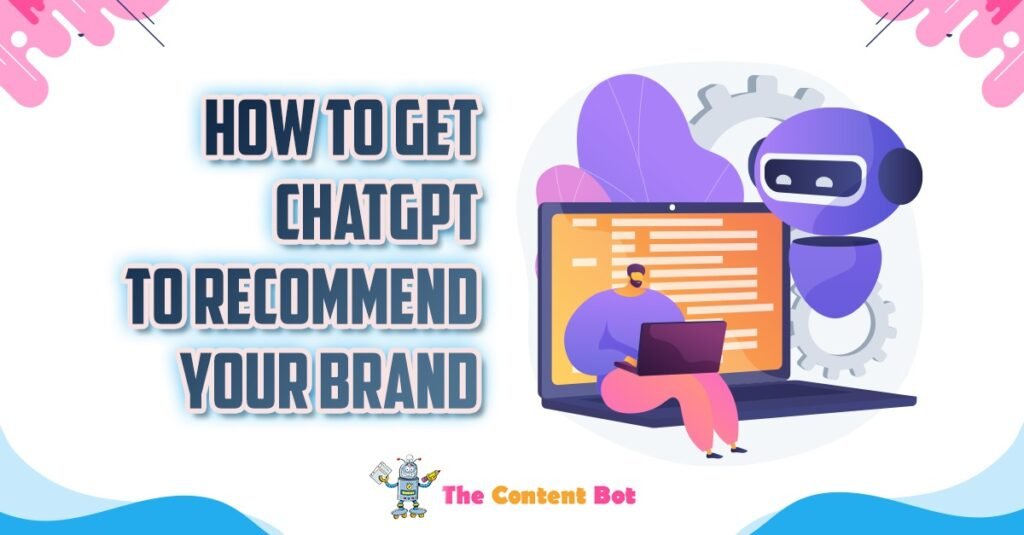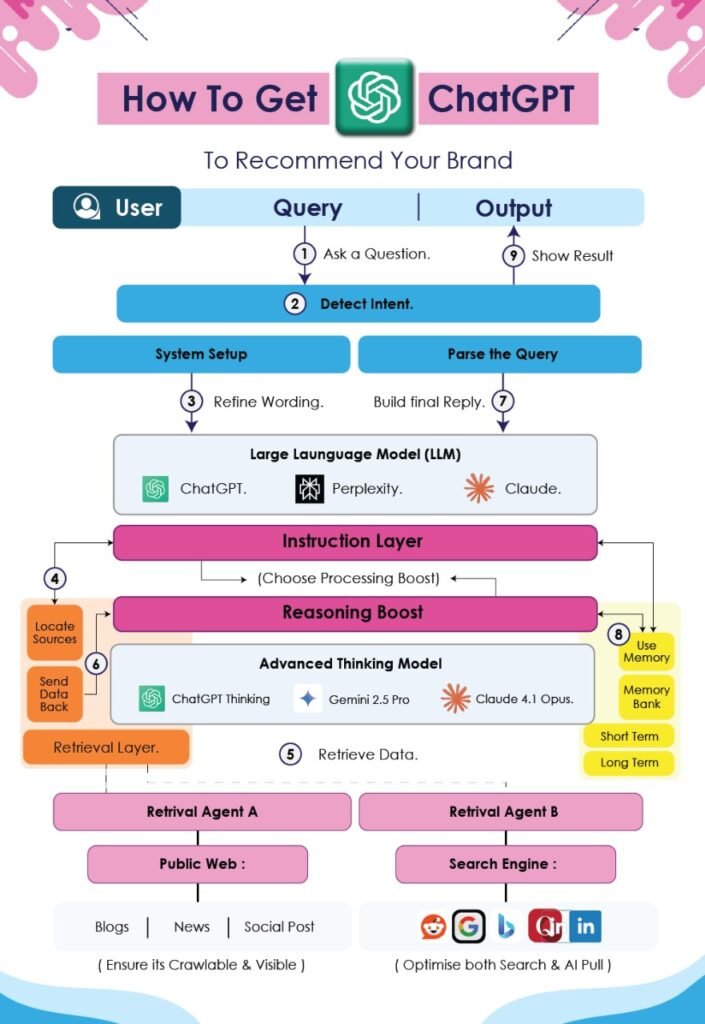
ChatGPT Brand Recommendations AI tools like ChatGPT are shaping how people discover products, services, and brands online. But here’s the big question: how do you make sure Chat GPT actually recommends your brand when someone asks a question?
It’s not magic, it’s about understanding how the system processes queries and positioning your brand in the right way. Let’s break it down step by step.

Step 1: The User Query
It all begins with a simple action: the user asks a question.
For example:
- “What’s the best digital marketing course in Tamil Nadu?”
- “Which ride-hailing service is better in Chennai?”
At this stage, the AI doesn’t yet know what to recommend; it’s only looking at the raw query.
Step 2: Detecting Intent
The AI’s first job is to figure out what the user really wants.
- Are they looking for information?
- Are they comparing options?
- Do they want to take action (like buying or booking)?
If your brand isn’t aligned with these user intents in how it presents itself online, ChatGPT won’t see you as a relevant answer.
Step 3 & 7: System Setup and Parsing the Query
Once the intent is detected, the AI goes through two key processes:
- System Setup (Step 3): Refining the wording of the question to make sense of it.
- Parse the Query (Step 7): Building the final reply that will eventually be shown to the user.
This is where the Large Language Models (LLMs) come in ChatGPT, Claude, Perplexity, and others.
If your brand is absent from the digital conversation (blogs, news mentions, social content), the LLMs have nothing to pull from.
Step 4 & 5: Retrieval Layer Locating and Pulling Sources
ChatGPT Brand Recommendations Here’s where the magic happens for your brand visibility.
ChatGPT relies on retrieval agents to go out and fetch information.
- Retrieval Agent A: Pulls data from the public web (blogs, news articles, social posts).
- Retrieval Agent B: Pulls from search engines (Google, Bing, LinkedIn, Quora, Reddit, etc.).
If your brand content is not crawlable, visible, and optimized for both AI and search engines, Chat GPT won’t be able to recommend it.
Think of this step as the “visibility check.”
Step 6: Sending Data Back for Processing
Once the sources are found, the retrieval agents send the data back into the system.
Here, advanced thinking models like ChatGPT Thinking, Gemini 2.5 Pro, and Claude 4.1 Opus process the information more deeply.
This stage gives an extra reasoning boost meaning, the system now compares, filters, and evaluates which answer best fits the user’s intent.
If your content has authority, recency, and clarity, it increases your chances of being the chosen answer.
Step 8: Memory and Context
Modern AI doesn’t just answer in isolation. It also:
- Uses short-term memory for recent queries in the same session.
- Leverages long-term memory to build context from repeated user behavior.
This means if users consistently ask about your niche and your brand shows up, AI systems start associating you more strongly with that category.ChatGPT Brand Recommendations
Consistency in content is key here.
Step 9: Output – Showing the Result
Finally, the AI presents the final result to the user.
This output is the product of all the steps above: query detection, retrieval, reasoning, and memory.
If you’ve optimized your brand for visibility across public web sources, search engines, and AI-crawlable platforms, this is where your brand appears as the recommendation.
What This Means for Your Brand
Getting ChatGPT (and other AI systems) to recommend your brand isn’t about gaming the algorithm, it’s about aligning with how AI thinks and retrieves data.
Here’s what you need to focus on:
- Be discoverable: Ensure your brand content (blogs, social posts, news mentions) is crawlable and indexed.
- Be optimized: Don’t just do SEO for Google think AEO (Answer Engine Optimization) to align with AI queries.
- Be consistent: Publish content that reinforces your brand’s relevance in your niche.
- Be authoritative: Build trust through thought leadership, case studies, and social proof.
Final Thoughts
Chat GPT Brand Recommendations The future of brand discovery isn’t just about ranking on Google anymore it’s about being AI-ready.
If you want ChatGPT (or any advanced AI) to recommend your brand, you need to create content that’s visible, optimized, and aligned with user intent.
Because at the end of the day, AI can only recommend what it can find. If your brand isn’t part of the conversation, you won’t be part of the answer.
Pro tip: Start treating your content as if you’re writing directly for Chat GPT to read. That’s the fastest way to make your brand part of the AI-driven recommendation engine of the future.

